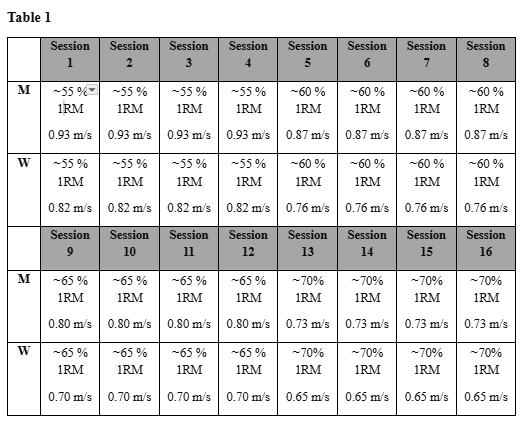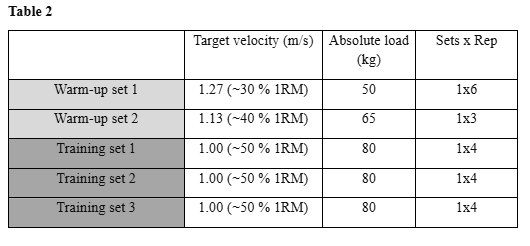5 de May de 2025
Strength and Conditioning Velocity Based Training
How to Use Data to Monitor and Adjust Your Strength and Conditioning Program
INTRODUCTION
Resistance training (RT) is widely acknowledged for its role in improving strength, power, and muscle hypertrophy, as well as promoting general health and fitness (Pareja-Blanco et al., 2014). Since training outcomes depend on the stimulus applied (Spiering et al., 2008), managing key variables—especially intensity—is crucial. Intensity, in particular, is considered a primary factor in strength development (Kraemer & Ratamess, 2004), which has generated great interest in finding objective methods for monitoring it in practice (Baechle & Earle, 2008).
HOW TO DETERMINE AND MONITOR INTENSITY THROUGH VBT
The one-repetition maximum (1RM) method is commonly used to prescribe training intensity, but it fails to account for daily performance fluctuations, which can lead to inaccurate load assignments (González-Badillo et al., 2011; Dorrell, Smith & Gee, 2019). Frequent 1RM testing is impractical and may disrupt training by inducing fatigue and reducing specificity (González-Badillo & Sánchez-Medina, 2010). Since 1RM values can fluctuate due to fatigue or adaptations, relying on outdated measurements presents a challenge for coaches aiming to prescribe accurate training loads.
To overcome this, velocity-based training (VBT) has been proposed as a practical alternative, allowing real-time load adjustments based on bar velocity (Weakley et al., 2020). Since each %1RM is related with a specific mean concentric velocity, VBT enables precise intensity control without repeated maximal testing. This relationship has been confirmed across various exercises and populations, improving training individualization (Sanchez-Medina et al., 2017; Pareja-Blanco et al., 2020).
HOW TO ADJUST THE INTENSITY IN EACH SESSION THROUGH VBT
VBT differs from traditional methods by allowing real-time adjustment of training loads to match the intended relative intensity, instead of relying on a pre-session 1RM test. For instance, in a full squat program using 55–70% 1RM over 16 sessions, target velocities can be set for each day, and the actual load adjusted accordingly within a small margin of error (±0.03 m/s), using established velocity-load equations in men and women (Pareja-Blanco et al., 2020). This approach enables athletes to train at the correct intensity, even with daily fluctuations.

Warm-up sets can be used to determine movement velocity and adjust loads before the training sets, a method supported by previous studies (Pareja-Blanco et al., 2020a; 2020b). For example:
- An athlete has to train 3 sets of 4 repetitions at 1.00 m/s (~50% 1RM).

This same adjustment could be made if the individual load-velocity relationship were obtained, since the literature suggests using individual equations instead of general ones to improve individualization and control during training (Banyard et al., 2018).
IS IT PREFERABLE TO ADJUST THE INTENSITY THROUGH VBT OR NOT?
Jiménez-Reyes et al. (2021) compared two RT approaches differing only in how training loads were prescribed: one group used a fixed load based on an initial 1RM, while the other adjusted loads daily using VBT. That is, one group lifted the absolute load corresponding to the programmed relative intensity based on their initial 1RM, with velocity monitored but not used for training. And the other group lifted with loads adjusted to the programmed relative intensity in each session to achieve the session goal through VBT. Both groups trained with identical volumes (sets and reps), using loads ranging from 50–80% 1RM. The study aimed to compare the effects of both protocols on 1RM strength, countermovement jump (CMJ) and sprint performance.
Interestingly, the non-adjusted load group, which experienced lower velocity loss in the set compared to the adjusted load group, achieved greater improvements in full-squat strength, CMJ height, and sprint performance. This might suggest that not adjusting the load in each session would be better than adjusting it. However, not adjusting the load in each session, caused the protocol that did not adjust the load to train at a higher average velocity during the sessions and, therefore, with a lower relative intensity, and even with a lower level of effort because the velocity loss during the set was smaller. These results suggest that lower fatigue and higher movement velocity per set, even without daily load adjustment, can effectively enhance performance. This supports previous research on the role of velocity loss in strength adaptations and the utility of VBT in managing training intensity (Pareja-Blanco et al., 2020a; 2020b).
Figure 1. Extracted and adapted from Jimenez Reyes et al (2021)
As can be seen in Figure 1, the group that did not adjust the load performed a greater number of repetitions at higher velocities. This is because in this group it was observed between the pre-programmed and the actual relative intensity as training progressed, becoming significant from session 5 onward. This discrepancy led to consistently lower velocity losses and higher mean velocities from session 6 onward, compared to the adjusted load group. This highlights the importance of coaches monitoring these shifts to decide whether load adjustments are necessary.
CONCLUSIONS AND PRACTICAL APPLICATIONS
These findings highlight the importance of using VBT to detect fluctuations in performance and identify mismatches between planned and performed relative intensity. Without this method, discrepancies could go unnoticed, potentially leading to unintended training adaptations. By continuously monitoring execution velocity, coaches can not only ensure accurate load prescription but also track the training effect over time. For instance, lifting the same load at a higher velocity indicates improved strength (i.e., a lower %1RM). Identifying gaps between intended and actual resistance training can guide individualized adjustments, leading to more effective training. As such, VBT should be considered a key tool in optimizing training decisions and program design.
To wrap it up:
- Training Outcomes Depend on Accurate Intensity Monitoring: Traditional %1RM-based prescriptions can be inaccurate due to daily fluctuations in performance.
- VBT as an Objective and Real-Time Tool: Velocity-Based Training (VBT) allows coaches to estimate intensity and adjust loads on the fly based on bar speed, avoiding the need for frequent 1RM testing.
- Established Load-Velocity Relationships Guide Precision: Each %1RM corresponds to a mean velocity, which varies slightly between men and women. Using these relationships allows for individualized and accurate load prescriptions.
- Daily Adjustments Improve Intensity Control: Athletes can use warm-up sets to assess current readiness and adjust the training load to hit target velocities within a margin of ±0.03 m/s.
- Comparison Between Fixed and Adjusted Load Programs: Research (Jiménez-Reyes et al., 2021) showed that both adjusted and non-adjusted groups improved performance, but the non-adjusted group trained at lower relative intensities with less fatigue and achieved greater gains—highlighting the role of velocity loss rather than daily load adjustment alone.
- Velocity Monitoring Helps Track Adaptations: Increases in movement velocity at the same load suggest strength gains. Monitoring bar speed helps coaches identify mismatches between planned and actual intensities.
- Practical Application for Coaches: Use VBT to track fatigue, adjust training loads, and detect performance trends. Even when daily load adjustments aren’t made, velocity monitoring provides valuable insights for programming.
REFERENCES
Baechle TR, Earle RW. 2008. Essentials of strength and conditioning. Edition 3rd. Cham- paign: Human Kinetics DOI 10.1017/CBO9781107415324.004.
Dorrell HF, Smith MF, Gee TI. Comparison of Velocity-Based and Traditional Percentage-Based Loading Methods on Maximal Strength and Power Adaptations. J Strength Cond Res. 2020 Jan;34(1):46-53. doi: 10.1519/JSC.0000000000003089. PMID: 30946276.
González-Badillo JJ, Marques MC, Sánchez-Medina L. The importance of movement velocity as a measure to control resistance training intensity. J Hum Kinet. 2011 Sep;29A:15-9. doi: 10.2478/v10078-011-0053-6. Epub 2011 Oct 4. PMID: 23487504; PMCID: PMC3588891.
González-Badillo JJ, Sánchez-Medina L. Movement velocity as a measure of loading intensity in resistance training. Int J Sports Med. 2010 May;31(5):347-52. doi: 10.1055/s-0030-1248333. Epub 2010 Feb 23. PMID: 20180176.
Jiménez-Reyes P, Castaño-Zambudio A, Cuadrado-Peñafiel V, González-Hernández JM, Capelo-Ramírez F, Martínez-Aranda LM, González-Badillo JJ. Differences between adjusted vs. non-adjusted loads in velocity-based training: consequences for strength training control and programming. PeerJ. 2021 Mar 23;9:e10942. doi: 10.7717/peerj.10942. PMID: 33828909; PMCID: PMC7996068.
Kraemer WJ, Ratamess NA. Fundamentals of resistance training: progression and exercise prescription. Med Sci Sports Exerc. 2004 Apr;36(4):674-88. doi: 10.1249/01.mss.0000121945.36635.61. PMID: 15064596.
Pareja-Blanco F, Rodríguez-Rosell D, Sánchez-Medina L, Gorostiaga EM, González-Badillo JJ. Effect of movement velocity during resistance training on neuromuscular performance. Int J Sports Med. 2014 Oct;35(11):916-24. doi: 10.1055/s-0033-1363985. Epub 2014 Jun 2. PMID: 24886926.
Pareja-Blanco F, Walker S, Häkkinen K. Validity of Using Velocity to Estimate Intensity in Resistance Exercises in Men and Women. Int J Sports Med. 2020 Dec;41(14):1047-1055. doi: 10.1055/a-1171-2287. Epub 2020 Jul 20. PMID: 32688415.
Pareja-Blanco F, Alcazar J, Cornejo-Daza PJ, Sánchez-Valdepeñas J, Rodriguez-Lopez C, Hidalgo-de Mora J, Sánchez-Moreno M, Bachero-Mena B, Alegre LM, Ortega-Becerra M. Effects of velocity loss in the bench press exercise on strength gains, neuromuscular adaptations, and muscle hypertrophy. Scand J Med Sci Sports. 2020a Nov;30(11):2154-2166. doi: 10.1111/sms.13775. Epub 2020 Aug 2. PMID: 32681665.
Pareja-Blanco F, Alcazar J, Sánchez-Valdepeñas J, Cornejo-Daza PJ, Piqueras-Sanchiz F, Mora-Vela R, Sánchez-Moreno M, Bachero-Mena B, Ortega-Becerra M, Alegre LM. Velocity Loss as a Critical Variable Determining the Adaptations to Strength Training. Med Sci Sports Exerc. 2020b Aug;52(8):1752-1762. doi: 10.1249/MSS.0000000000002295. PMID: 32049887.
Sánchez-Medina L, Pallarés JG, Pérez CE, Morán-Navarro R, González-Badillo JJ. Estimation of Relative Load From Bar Velocity in the Full Back Squat Exercise. Sports Med Int Open. 2017 Mar 28;1(2):E80-E88. German. doi: 10.1055/s-0043-102933. PMID: 30539090; PMCID: PMC6226068.
Spiering BA, Kraemer WJ, Anderson JM, Armstrong LE, Nindl BC, Volek JS, Maresh CM. Resistance exercise biology: manipulation of resistance exercise programme variables determines the responses of cellular and molecular signalling pathways. Sports Med. 2008;38(7):527-40. doi: 10.2165/00007256-200838070-00001. PMID: 18557656.
Weakley J, Mann B, Banyard H, McLaren S, Scott T, Garcia-Ramos A. 2020a. Velocity- based training: from theory to application. Strength & Conditioning Journal. Epub ahead of print May 19 2020 DOI 10.1519/SSC.0000000000000560.
